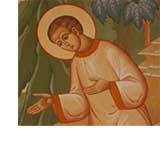Will the writers of the twenty-first be so concerned? The remedy for this condition has been readily available to the people of the world for nearly two millennia. "Come to me," are the words used by Jesus Christ to extend an invitation to all humankind to enter into a covenant of friendship with God and to live in a community of believers. It is a truly catholic beckoning; a call to become a member of the Body of Christ.
 Seven is the perfect number as referenced in biblical literature: seven days completes the act of creation in Genesis, seventy years is the perfect life span. In this article I would like to consider seven expressions or bodies of Christ. Seven is the perfect number as referenced in biblical literature: seven days completes the act of creation in Genesis, seventy years is the perfect life span. In this article I would like to consider seven expressions or bodies of Christ.
1. Christ the baby.
The word of God came among us in the most appealing of human forms. In the purity and innocence of a newborn, humanity is reminded of its pristine origins and is drawn without fear before the presence of the great I AM. For the first time in human history, the creation approaches the Creator in the tranquil atmosphere of mutual love.
2. Christ the youth.
This is the most ambiguous period of human development: boldness and passivity, certitude and doubt, depth and superficiality. Jesus becomes a comforting guide through this passage of years; this period of becoming featured by episodes of surprising grace followed by those of embarrassing awkwardness. One is led by the Lord's example to wisdom and maturity.
3. Christ the man.
The years of Jesus' ministry redefines the criteria by which one assesses human meaning and productivity. Faith and perseverance in seeking the will of God leads to the ultimate success in living. The total of one's achievements is valued less by the creations of one's hands and more by the inclinations of one's heart.
4. Christ the transfigured.
Neither truck loads of concoctions nor oceans of self-improvement techniques can make manifest the glory of our being. The image of the glorified Christ narrated by Peter, James, and John is a revelation not only of the divine nature of Christ but also of the possibilities within human nature. Someone once said, "The soul is a fire that darts its rays through all the senses; it is in this fire that existence consists."
5. Christ the crucified.
Jesus endured the full force of human sin. Evil holds high festival in a human mind coerced by fear or acting in deluded righteousness. This type of zeal is an area of the geography of human nature not to be celebrated but to be redeemed. The cross bearing the broken, battered body of Christ beckons the human to heart-rending contrition and to humble pleas for reconciliation. Thus awaits the healing God.
6. Christ the Risen Lord.
The empty tomb was full of love, immortality, salvation and a hope that only faith can give. The Holy Spirit has fashioned the soul into a splendid partnership of grace and will continuing the work of salvation in the world. It has been said, "We must never separate what God does for us from what God does in us."
7. Christ the Church
Today the community of the Church represents the continuing presence of Christ in the world. Under the guidance of the Holy Spirit, the people who are the Church extend the work of Christ in the proclamation of the Gospel and the visible acts of grace that give humanity its dignity and its hope.
back to top
|



